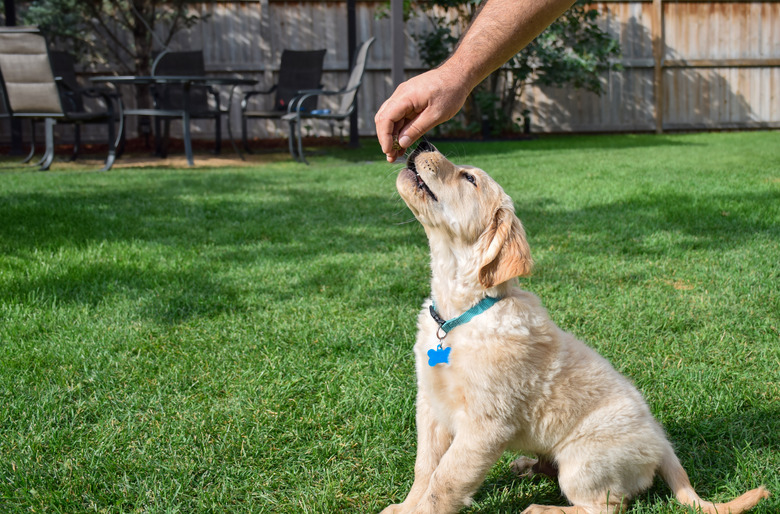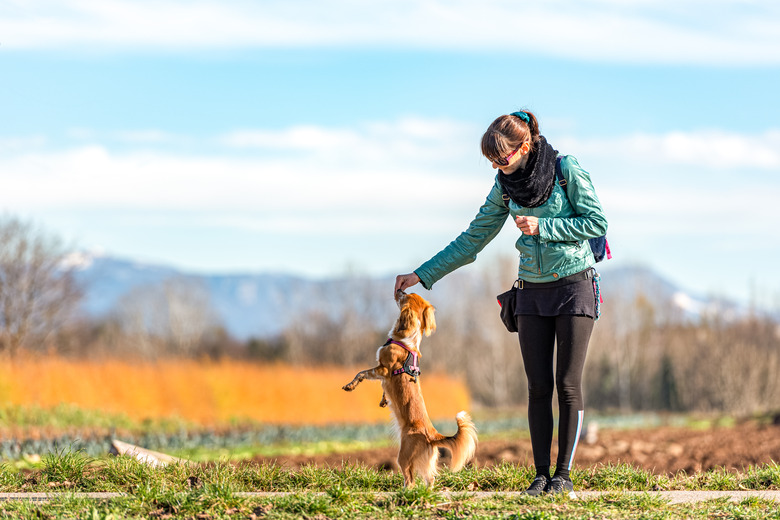The Do's And Don'ts Of Using Treats As Positive Reinforcement When Training
Training your new puppy can feel daunting for new pet parents — especially if you've never done it before. But don't fret if your pet's training milestones differ from what the internet or an acquaintance tells you. All pets are different, so what works for one may not work for another.
One training activity that's universally approved by experts (and dogs)? Using food rewards during training, says certified behavior consultant and co-founder of Clickstart Dog Training Academy Liv Healy, CBCC-KA, FFCP.
Healy is sharing guidance on the do's and don'ts of using treats during training below, so get ready to take notes (and make sure to have plenty of Blue Buffalo treats on hand for practice). A fan favorite among the canine crowd, Blue Buffalo treats are made with natural ingredients and without artificial flavors or preservatives — so not only will your pet love them, but you'll feel good about giving a treat that's good for them.
Do: Employ positive reinforcement
Do: Employ positive reinforcement
Like us, our pets enjoy getting a reward for a job well done. Whether that be offering praise for sitting on command or giving them a treat when they climb into their bed instead of onto the sofa (if that's an off-limits area), proactively rewarding their good behaviors means that they will engage in those positive actions more often, and subsequently, perform the unwanted ones less, Healy says.
The easiest way to use positive reinforcement? "While there are many things that can potentially reinforce our pets, training with treats and food tends to be one of the most efficient and effective ways to build and change behavior," Healy says.
Do: Try the SMART protocol
Do: Try the SMART protocol
If you're looking for more guidelines on when to treat, Healy suggests trying to follow the "SMART" acronym, coined by Kathy Sdao, which stands for "see, mark, and reward training." To start, Healy says to get a few containers and a measured number of your pet's favorite treats. The goal is to give your pet all the treats throughout the day by noticing and reinforcing the positive behaviors your pet is already doing.
"You can reward them for [lying] on their beds, playing with their toys, quietly watching things pass the window, et cetera," Healy says. "The more we reward the good, the more those behaviors will happen for us, which leaves even less time for the behaviors we don't like."
Do: Find a treat your pet loves
Do: Find a treat your pet loves
Your pup's tastebuds aren't to be overlooked when it comes to treating and training. Healy says finding a treat your dog really loves can have a huge impact on the training process. "I meet so many clients who initially believe their pet 'isn't food-motivated,' but once we find the magic treat they go wild for, we can use it to our advantage for some great training," they say.
In addition to finding a treat your dog thinks is tasty, you'll want one that supports their overall well-being as well. This is where you can work with a veterinarian to find a high-quality treat brand that provides great nutritional value — such as Blue Buffalo, which offers treats in tons of flavors that contain natural ingredients enhanced with vitamins and minerals, and no artificial flavors or preservatives.
Don’t: Engage in aversive training strategies
Don't: Engage in aversive training strategies
Another way pets are just like us: They don't enjoy being punished for bad behavior. Some aversive training strategies include yelling, physical corrections, and other intimidation methods. Even if you give them a treat later, this won't heal the hurt your pet will feel from these punishments.
"Using positive reinforcement has been proven time and time again to be not only highly effective, but without the risk of fallout and negative consequences that is common with aversive training strategies," Healy says.
Don’t: Struggle with treating your pet alone
Don't: Struggle with treating your pet alone
The snuggles and kisses are wonderful, but having a new pet can also be hard. That's why it's important to remember that you're not alone in this training journey, even when it feels like you might be. If you're having trouble effectively employing treats during training, don't be afraid to reach out to an expert for assistance.
"There can be a lot of nuance in using treats effectively during training," Healy says. "If you are struggling with your pet, it's worth reaching out to a qualified, certified professional trainer or behavior consultant."
Don’t: Forget to bring treats on outings
Don't: Forget to bring treats on outings
There are a lot of fun activities you can do with a new pet, such as going on a walk, taking them to a pet park, or even bringing them to work. On all of these adventures, Healy recommends bringing some of your pet's favorite treats with you.
"Even if you don't use them, having the ability to spontaneously reward behavior you like opens up a huge world of training opportunities," Healy says. Plus, bringing them will help to manage their behavior, recover from stress, and keep building those positive associations, even when you're on a not-so-fun trip (think: the vet).
Don't: Over-treat your pet
Don't: Over-treat your pet
Although you may want to give your dog a treat just to see their tail wag, be careful that you're not giving them too many treats (not to say you should never give them a treat to see their tail wag though). This balance can be especially hard to strike during training because the temptation to constantly treat may be stronger. Healy says that using fewer of your dog's most favorite treats instead of a lot of their less-loved treats can actually make a bigger impact during training.
"Generally speaking, treats should not account for a large percentage of your pet's diet," Healy says. "Your vet team is a great resource for determining the exact amount allowable."
In summary
In summary
Using treats is possibly the most effective way to use positive reinforcement while training your new pet. Although it might take some experimenting to find what treats and methods work best for you and your beloved pet, keep persevering and remember that your pet (and you) have a support system cheering you both on. Happy treating and training!

